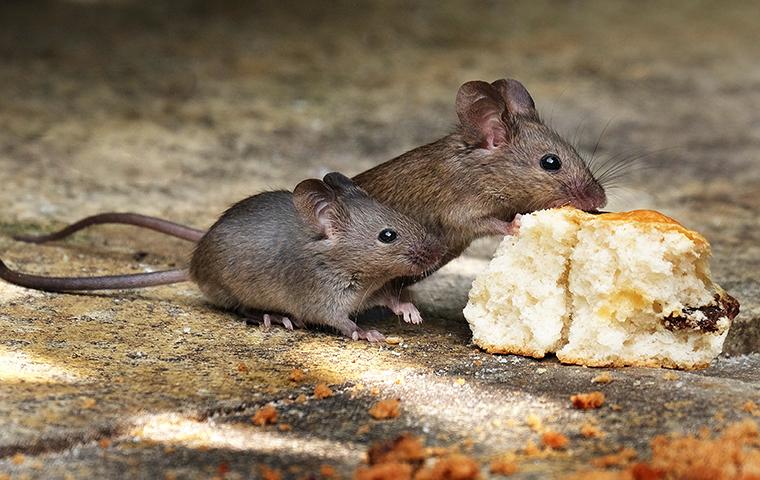In St. Charles, we have a variety of field mice. The worst of all field mice is the common house mouse. When house mice get into our homes, they find everything their little mice hearts have ever wanted. Our homes can provide hiding places from predators, 20 meals a day, and safety from the elements. So, the best way to deal with mice is proactive mouse prevention. Join us today as we share everything you need to know to establish the best mouse prevention and control strategy. We'll look at how to detect signs of a mouse infestation, how to evaluate the risks, and how to apply mouse-proofing to keep mice out. Some of the facts you'll learn today are likely to surprise you, so expect a little bit of fun as you learn about how to prevent mouse problems!
Do you already have a mouse problem? If so, it is best to get professional rodent pest control in St. Charles. Jump to our contact page and share with us about what you’re seeing or hearing. Pest Control Consultants provides advice, insights, and mouse control services. We can help!

Signs Of A Mouse Infestation: How To Spot Them Early
It is essential to catch signs of mice in your house early. Why? It is important because mice can grow their numbers startlingly quickly if they find favorable conditions inside a home. One little mouse can create a litter of 5 to 12 pups every 19 to 21 days. Those pups can start to mate and reproduce in as little as 6 weeks. Generally, each female mouse will have 10 litters per year. Plus, mice are social animals that work well together. It is easy for a home to get overrun with mice! All those critters need is food.
We mentioned above that mice can eat 20 times a day. While they don't eat much at each meal, they eat frequently. There are two things to understand about their frequent feedings. First, they're going to get into your kitchen, pantry, and other places where food is found. Second, they'll want to live in your home if they are able to get frequent meals. With their strong incisors, mice can chew through paper, thin plastic, and cardboard packaging to access food. Looking for this damage is the first way to tell that mice are in your home.
Mice in St. Charles cause other damage you can use to detect them. They chew small holes in wood, plaster, sheetrock, and other building materials. Look low and in concealed locations. Check around the pipes under your kitchen sink or bathroom sinks. Take a look behind your oven.
When you go looking for signs of a mouse problem, use a flashlight. These tiny rodents prefer to stay hidden in dark places. Here are some of the signs you may find:
- Dark brown or black fecal pellets are a useful sign. Mouse droppings are smaller than grains of rice. If you find dark pellets that are moist, you've found fresh droppings. If you find gray pellets that are brittle, you've found old droppings.
- Clean the droppings and check back later to see if more appear. Doing so will help you to determine if you are dealing with an active infestation.
- Mice leave footprints or hair as they explore. A dusty surface or shelves with food debris can help you see footprints. If you have good eyes, you may also see tiny mouse hairs to confirm your suspicions.
- Mice create soft nests in hidden places. Inspect your attic for these nests. You may find gathered material in a recess or void. You may also find the soft materials in the drawer of a desk or dresser stored in your attic.
- Mice sometimes make detectable noises inside wall cavities. If you hear bumping and scraping, you may have a mouse in there. Often, mice make no detectable noises, but you may still detect them if you have a pet. Dogs and cats have better hearing than you do. When a dog or cat acts strange in a kitchen, it could be an indication of mouse activity.
When you find evidence of mice in your home, the next step is to evaluate the risks of having those little critters living with you. Let's look at the risks so you can decide what to do about those pests.
Why Mice Are A Problem: Health Risks And Property Damage
How much of a problem can one little mouse present? The main issue is that you're not likely to have one mouse. As we pointed out, mice are social animals that work together. They also grow their populations quickly. Here are a few ways they can pose health risks or damage property as they raise multiple families in your home:
- Mice chew on wires. The worst outcome of a mouse infestation is a house fire.
- Mice don't go outside to use the restroom. Their waste materials are a source of contamination and will also damage your property.
- Mice may pick up bacteria and spread invisible organisms that are associated with stomach illness, such as salmonella.
- Mice have ticks and fleas, which are associated with human pathogens.
- Mice create holes that allow other pests into your home.
- Mice damage seals and allow moisture into your home, which can lead to mold problems.
Mice aren't harmless. There are many ways they can accidentally harm you, your kids, or your pets. It is best to remove all mice from your home. Contact Pest Control Consultants for professional mouse control in St. Charles. If you don't have mice yet, we strongly recommend taking the time to apply preventative measures. Let's look at some smart ways to keep mice out, and why these measures work.
Preventative Measures For Mice: Keep Them Out Before They Get In
The reason so many St. Charles residents deal with mouse infestations is that they don't know how to keep mice away. The first step in mouse-proofing your home is to make your exterior inhospitable to mice.
- Consider bird feeders. Seeds are a dietary staple for mice.
- Consider garbage. Believe it or not, a mouse could get into your trash. They can jump a foot in the air and use objects near your trash in order to get inside. Keep your trash tightly covered.
- Consider ground clutter. Mice use objects on the ground in ways that may surprise you. Mice use their whiskers like a blind man uses a cane, their ears like sonar, and their noses like super sniffers. If you remove objects from the ground, you remove one way mice navigate across your yard.
- Consider dense vegetation. Mice hide in vegetation. Trim plants near the base to open things up.
- Consider voids underneath structures. A mouse is more likely to chew a hole and enter your home if it finds a spot that helps to protect the little mouse from predators, such as the dark space under your back deck. Apply fencing material or hardware cloth to keep them out.
Once you've addressed factors that can lead to an increase in mouse activity near your foundation and exterior walls, you must consider entry points. Prepare to be amazed. Mice get into St. Charles homes in inexplicable ways.
- A mouse can turn a hole the size of a pencil into a hole the size of a nickel. If a mouse is determined, it can scrape away concrete around a pipe to enter your home. You can apply expanding foam to keep most mice out because the foam removes the tiny gap that a mouse will want to gnaw on. So, while they can chew through the foam, they won't think to do so.
- A mouse can squeeze through a gap the width of a dime. A mouse can chew through the rubber of a door sweep or weatherstripping, but these materials keep mice out when they're in good condition because mice don't see those tiny gaps that make them want to gnaw their way in.
- A mouse can scale rough surfaces, like tree bark and bricks. You might think we're kidding, but a mouse can climb some exteriors and get all the way up to a gable vent. It's true. Apply hardware cloth to guard vents, even at the top of your home. Also, trim tree branches to keep mice off your roof.
- A mouse can climb up certain downspouts. We recommend applying a material to keep mice out of your downspouts and gutter system.
- A mouse can climb up a pipe. You can stop mice from doing this if you apply a mouse guard, which typically looks like an upside-down cone.
- A mouse can run across a wire. Squirrels aren't the only rodents that use wires as superhighways in the sky. The tail on a mouse helps it to have amazing balance. Use guards on wires to prevent mice from accessing your roof from powerlines.
Do you see how hard it is to keep mice out? You have to work at it, but if you're diligent, and leave no opening unsealed, you can stop mice from getting into your home. Now, let's look at how to get rid of mice after they have invaded your home.
The Importance Of Professional Mouse Control Services
Mice are accidentally harmful to humans and quickly grow their numbers. The longer you wait to deal with an infestation, the more trouble mice are able to cause. Also, it is more costly to deal with a mouse infestation that has matured. It is best to prevent mice as best you can, detect them early, and contact a licensed professional at the first sign of mouse activity in your home. If you have higher-than-normal mouse pressures, you can also get exterior management. For home pest control in St. Charles, contact Pest Control Consultants. We'll help you find the right solution that fits your needs and budget. Jump to our contact page for help!
 Customer Reviews
Customer Reviews
